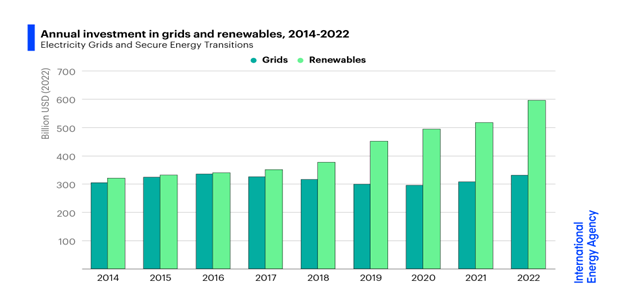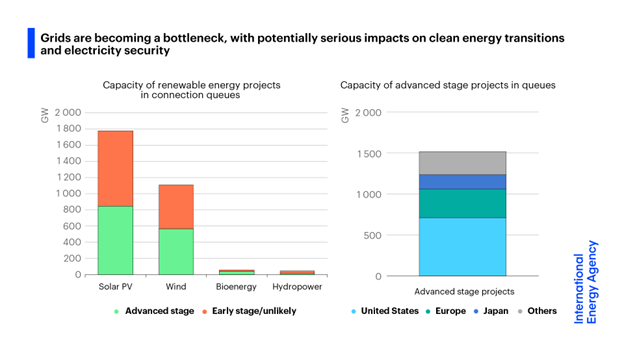- The International Energy Agency concluded that the world needs to double the size of its existing electricity grid in 17 years to power the globe with renewable energy.
- The 49.7 million miles of new and rebuilt transmission is almost 2,000 times the circumference of the Earth.
- The costs would be enormous, as it involves duplicating our existing system built over a century with one built by 2040.
According to the International Energy Agency (IEA), the world has to add or replace 49.7 million miles of transmission lines by 2040 in order for countries to meet their climate goals through the use of renewable energy and to meet electricity demand. That amount of transmission lines needed is about equal to the total number of miles of electric grid that currently exists in the world, which took 100 years to build and is 1,996 times the circumference of the Earth. According to the IEA, this level of construction of transmission lines across the globe will require the annual investment in electric grids of more than $600 billion per year by 2030, which is double what current global investment levels are in transmission lines. It is a huge and little discussed additional cost needed for renewable energy. The lack of transmission is holding up 1,500 gigawatts of renewable energy projects that are in “advanced stages of development,” which are waiting to get connected to the grid. The 1,500 gigawatts is five times the total wind and solar power added to the grid worldwide in 2022. Adding the required transmission mileage to the grid also requires changes in how the electric grid in each country is operated and regulated.
According to the IEA, investment in renewables has nearly doubled since 2014, but investment in transmission has barely changed, as the figure below shows. With the notable exception of China, investments in grids have been declining in many countries.

Background
Electric grids were originally constructed to bring electricity from locations where fossil fuel or nuclear plants were located to where electricity demand centers are located, mainly in cities. Wind turbines and solar farms, however, are located much further from demand centers than fossil fuel and nuclear plants because they need to be located where the wind and solar resources are most prevalent, that is, where the best winds are and where the sun is the strongest. Those sites are usually far from existing generating stations and far from city centers, which is why the massive increase in transmission is needed.

Further exasperating the problem is that the European Union and the Biden administration want to totally electrify their energy systems, greatly increasing the demand for electricity that will require huge amounts of land and wire for the wind and solar plants. The Biden administration has proposed simultaneous EPA rulemakings to zero out coal and natural gas plants, and to mandate the adoption of electric vehicles, even if the grid will not be able to sustain them. The Biden administration is also working on banning gas stoves and states such as California and New York are working on banning gas furnaces and water heaters.
Further, transmission lines take a very long time to build, especially compared to other parts of the energy infrastructure. Building new transmission lines takes between five and 15 years, including planning and permitting. By contrast, new renewable energy projects take between one and five years, and new infrastructure for charging electric vehicles takes less than two years. According to the IEA, investing in transmission line infrastructure needs to happen now or it will become a larger and more limiting factor in global decarbonization plans. The effort is massive given that many developing countries barely have an electric grid and little funds to build one. So, those countries need handouts from developed countries, who are also inundated with massive costs for implementing their own energy transition, which is increasingly being felt by consumers who must pay for the politicians’ efforts to “electrify everything.”
Obstacles to Transmission Line Construction
Many countries are struggling to build new power lines, which face opposition from residents. For example, the Südlink transmission project in Germany was originally proposed in 2014 to bring wind power from the North to help replace power from nuclear reactors in the South that were scheduled to close. Public opposition forced developers to bury the lines underground, causing delays and tripling the cost. The line is not expected to be finished until 2026 at the earliest. In the United States, it took 17 years for developers to win approval for the SunZia project, a 550-mile transmission line from a wind farm in New Mexico to consumers in Arizona and California, due to years of legal battles and route changes. Transmission is intrusive and unsightly to many homeowners who live in open spaces that may be needed for transmission projects serving urban residents who demand “clean energy” that may also be generated in someone else’s backyard.
The transition to electric vehicles is adding to the burden. Utilities must upgrade local infrastructure in cities, such as transformers and distribution lines, to handle an influx of power demand from electric vehicle charging stations that also takes time. In the Netherlands, for example, it will take until 2025 for about 3,000 neighborhoods to install car charging ports. Because of heavier demand for 240 volt and even 3 phase power, significant changes in electric service must be anticipated and planned.
Each country faces different challenges in upgrading their grids. In India, Indonesia and South Korea, local utilities do not have the investment funds. In much of sub-Saharan Africa, millions of people lack access to electricity and the high cost of borrowing is a major problem. In the United States, European Union and Japan, permitting reform is needed.
A report by the Brattle Group estimated that utilities in the United States could save $35 billion per year if they used existing grid infrastructure more efficiently — such as staggering the times when people charge their electric cars, or using home batteries and rooftop solar power to juggle the flow of power or paying businesses to use less electricity when demand is peaking. But, many of the suggestions are more third world issues than what a vibrant economic economy needs and turns the promise of always available – “ready”– electricity as “Reddy Kilowatt” on his head.
Conclusion
The IEA released a report that alerts economies to the enormous task and expense needed to construct the transmission lines that wind and solar power and the transition to electric vehicles need. The transition will not be easy, particularly at the speed in which Europe and the United States want the transition to be accomplished. It took 100 years to build the current electric grid and the IEA wants the enhancements consisting of the same amount of transmission lines to be completed by 2040—in just 17 years. Without the massive investment in transmission, more and more wind and solar plants will be waiting to hook up to the grid since it takes less time to construct them. In the United States, wait times to connect new power plants to the grid can reach five years or more.
Without the added transmission, climate goals that include adding vast amounts of wind and solar power, switching from gasoline-powered cars to plug-in vehicles and replacing gas furnaces with electric heat pumps will not be accomplished. Perhaps those goals and the expense need to accomplish them ought to be rethought.



